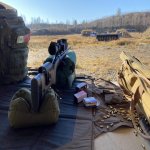Fascinating!
We're talking about a .22LR bullet designed to shoot short range with round or flat pointed head and flat base. The variables between lots become even more complex.
I've shot SK RM and Center-X in my 40XB and I have test groups that reveal sometimes huge differences between lots of ammo and different firearms. There's a reason why top end shooters have their firearms tested at Lapua or Eley and then buy a case or two of the most accurate.
PRS style shooting and looking to extend the range of the .22 LR accurately will be most challenging. Anytime long range shooting happens the bullet shape changes immediately to a spitzer/boat-tail combination and bullet staying supersonic to the target. Since, that is not happened to the .22LR yet, you are at the mercy of wind change of a small projectile that will open or tighten a group at any range. Are you guys using wind flags and watching them change all the way to 300 yds? I use flags to 50yds and have seen bullet deflection there.
Naturally, I'm also awaiting new developments that happen, not luck.
Whether we are talking about a Ruger or Vudoo rifle is immaterial. One is Production, the other is custom Open class.
We're talking about a .22LR bullet designed to shoot short range with round or flat pointed head and flat base. The variables between lots become even more complex.
I've shot SK RM and Center-X in my 40XB and I have test groups that reveal sometimes huge differences between lots of ammo and different firearms. There's a reason why top end shooters have their firearms tested at Lapua or Eley and then buy a case or two of the most accurate.
PRS style shooting and looking to extend the range of the .22 LR accurately will be most challenging. Anytime long range shooting happens the bullet shape changes immediately to a spitzer/boat-tail combination and bullet staying supersonic to the target. Since, that is not happened to the .22LR yet, you are at the mercy of wind change of a small projectile that will open or tighten a group at any range. Are you guys using wind flags and watching them change all the way to 300 yds? I use flags to 50yds and have seen bullet deflection there.
Naturally, I'm also awaiting new developments that happen, not luck.
Whether we are talking about a Ruger or Vudoo rifle is immaterial. One is Production, the other is custom Open class.








































































